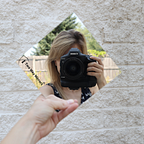History of Mirrors — 8,000 BC to Present Day
From rivers and obsidian, all the way to mercury and aluminum, mirrors have been evolving since the beginning of time.
The mirror, as we think of it, didn’t come about until around the 1800s. That didn’t necessarily mean that people had never seen their reflection; it just meant they had to be a little more crafty with it.
Before fancy tools and modern-day means of mass production came about, people would look at their reflections in the water. This may have been a river, a pond, or even a puddle — which most likely had distortions. Distortions or not, people were able to see a reflection nonetheless.
What about a mirror that you could physically hold in your hands?
Obsidian Mirrors
Welcome 8,000 BC. We are in the era of wheat cultivation and using obsidian stone for its reflective properties. Obsidian is produced by active volcanoes and was first used in Kenya for pottery and arrowheads. People figured out if the stone was heavily polished, it resulted in a beautiful reflection. This gave us the world’s first mirror!
The issue of using obsidian stone was the fact that it was so heavy. It wasn’t typically made into large pieces, but rather, small decorations for the wealthy. Over the years, obsidian has been increasingly associated with black magic.
Bronze Mirrors
Okay, now let’s fast forward a little bit. Between 3,000 and 2,000, we started to see mirrors made out of bronze. China and Egypt were the first to jump on this new trend — making mirrors out of flattened round disks of bronze.
Bronze mirrors typically had handles made of wood, metal, or ivory, so they were more suitable to be a handheld mirror. However, much like obsidian mirrors, they were typically made on the smaller side unless you had lots of money.
One of the best examples of a bronze mirror would be the Lighthouse of Alexandria in 280 BC. There was a large, curved mirror at the center that would reflect the light from a fire. This reflection appeared like a beam of light and would help guide those at sea back to safety. Money might not buy happiness, but it does buy lighthouses with fancy mirrors!
Fun Fact: Have you ever heard the story of the famous mathematician, Archimedes, using mirrors to burn down enemy ships? This supposedly happened in 212 BC, but there isn’t much historical evidence of this, so scientists are divided.
The legend has it that he set up a hexagonal mirror surrounded by other small mirrors to reflect sun rays onto Roman ships. They tried this method out on the show Mythbusters, but it didn’t really work correctly — maybe they didn’t have the special Archimedes touch.
Mercury Mirrors
Okay, now it’s time to fast forward a few thousand more years. Picture this: 15th-16th century Italy. Well, to be specific, we’re going to talk about the Island of Murano in Venice. Now I need you to picture a regular mirror, but better — a mirror designed so intricately and beautiful that at first, they were only for royals and nobles. Sound pretty great, right?
While they were beautiful and made of glass (hooray for technological advancements), they were coated in mercury. Mercury, as we all know, is a toxic substance and shouldn’t be getting daily use. So, they were headed in the right direction but still had a ways to go!
It was shortly after this that mirrors started to gain use for scientific purposes. In the 1700s, a mirror was used to build the first reflective telescope — but mirrors were still viewed as a luxury item.
Silver & Aluminum Mirrors
Now, we’re moving towards the modern-day mirror. It only took several thousand years, but I think we got it this time.
In 1835, Justus Von Liebig started using silver rather than mercury to coat the glass, thus creating the silvering process that we still use today. Glass itself isn’t very reflective, so it needs some sort of metal coating to make things visible. Being an effortlessly polished and fairly sturdy material makes glass the perfect choice for mirror making!
Silver is boiled down to a liquid, then applied in a thin, even coating on the glass. You can also spray liquid silver onto the glass, depending on what tools are available. After the silvering process, mirrors are covered in a protective coating to avoid chips in the reflection, then polished. If the polishing process isn’t done correctly, waves in the glass will cause distortion.
A technique that was developed a little later was using aluminum rather than silver to coat the glass. The aluminum is applied via vacuum and bonds directly to the cooled glass.
Unlike silver, aluminum won’t tarnish — but it still gives off that crystal clear reflection.
Fun Fact: Aluminum has the highest level of reflection of any other metal in the ultraviolet and infrared spectral ranges.
All the way from 8,000 BC to the present day, mirrors have held an important role in society. Originally used as a status symbol, to now, where we use mirrors for everything from laser technology to news teleprompters! We’ve come a long way already, so I’ll leave you with this question. What’s next?
